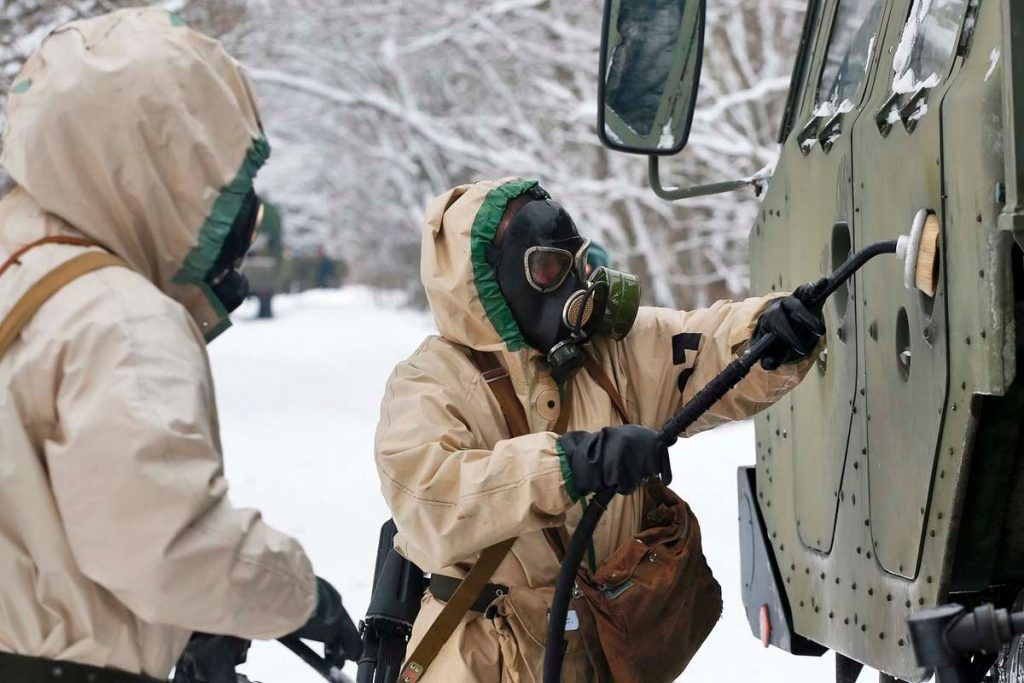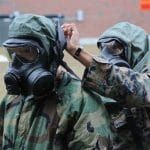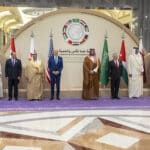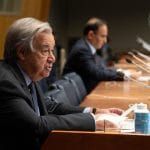Russia’s non-proliferation disinformation campaign
By Abigail Stowe-Thurston | March 22, 2022
 Russian troops undergoing training exercise. Image courtesy Ministry of Defence of the Russian Federation, Creative Commons Attribution 4.0 Licence
Russian troops undergoing training exercise. Image courtesy Ministry of Defence of the Russian Federation, Creative Commons Attribution 4.0 Licence
As approximately 100 diplomats walked out of the United Nations Human Rights Council in protest on March 1, Russian Foreign Minister Sergei Lavrov attempted to justify Russia’s invasion of Ukraine by claiming that Ukraine’s so-called “fascist” government sought nuclear weapons that could threaten the very Russian state itself. Russian officials, including President Vladimir Putin and Foreign Intelligence Service Director Sergei Naryshkin, have repeatedly accused Ukraine’s government of seeking weapons of mass destruction (WMD) with chemical, biological, radiological, or nuclear capabilities. These narratives have been spread on Kremlin-friendly media channels and online to rationalize the country’s invasion.
Even though specific claims about Ukraine seeking WMD are blatant falsehoods laced with inconsistencies, they should not be dismissed as inconsequential; they muddy the waters, making the truth more difficult to discern. Consequently, such false claims are wholly consistent with the aims of Russia’s broader disinformation strategy: to undermine global nonproliferation norms and institutions. Furthermore, US and allied intelligence suggests that Russia could take drastic action to follow up on its deceptive claims about Ukraine’s intentions, perhaps even preparing to use chemical weapons in a “false flag” attack after which Russia would try to pin the blame on Kyiv.
The Russian government has implemented—and continues to implement—its disinformation strategy across several different fronts. Russian officials and media outlets have inflated (or completely invented) threats posed by Ukraine that would justify a Russian invasion, including the presence of weapons of mass destruction and attempts to fabricate evidence that Ukraine was prepared to attack Russia. Russian leaders accompanied these efforts to fabricate and spread false narratives with attempts to obscure facts, sow confusion, and interrupt or reduce confidence in factual reporting. These mutually reinforcing initiatives were executed on a massive scale—what some observers call a “firehouse of falsehood”—as Russia unleashed a network of bots, trolls, state-affiliated media organizations, and official spokespeople to flood the information space with false and misleading narratives.
The goal is not to persuade audiences to believe a specific Kremlin-approved version of events, but to challenge observers’ ability to trust any narrative regardless of the supporting evidence—or lack thereof. These well-honed tools help the Russian government to achieve its political aims at the expense of democracy, public health, and efforts to restrain the proliferation of WMD, while evading attribution and accountability for its own malign actions.
The guns of November. The disinformation barrage on Ukraine expanded as Russia began massing tens of thousands of troops on its border with Ukraine and in the interior of Belarus over the winter of 2021. The US intelligence community warned that Moscow was likely to use fabricated footage of a false flag attack as a pretext for invading Ukraine. Their warnings were amplified by findings from open-source, public institutions such as the Atlantic Council’s Digital Forensic Research Lab, whose researchers found that Russian media mentions of “Ukrainian aggression” had increased by 50 percent in January 2022 compared to prior months.
US efforts to warn the world in advance of Putin’s plans succeeded in making his motives and efforts transparent, but they were only partially successful. While advance exposure of Putin’s plan reportedly led to the delay of the invasion, the attack still went on. And Russian officials and agencies continue to attempt to rationalize their attack on Ukraine by claiming that the government of Ukraine’s president, Volodymyr Zelensky, sought chemical, biological, radiological, or nuclear capabilities.
This campaign culminated in a televised address on February 24, in which Vladimir Putin announced the beginning of Russia’s military operations and said: “[Ukraine is] getting ready and waiting for the right moment [to attack Russia]. Moreover, they went as far as aspire to acquire nuclear weapons.” (Contrary to Putin’s accusations, Ukraine has been a party to the Nuclear Non-Proliferation Treaty since 1996, when it relinquished custody of the last Soviet nuclear weapons hosted on its territory in accordance with the 1994 Budapest Memorandum.) Continuing on this theme, the Kremlin-run Russian state news agency RIA Novosti alleged that Ukraine was perilously close to developing a dirty bomb, a relatively rudimentary type of explosive that disperses radiological material but does not cause a nuclear explosion.
For good measure, during his subsequent March 1 speech at the United Nations, Russian Foreign Minister Lavrov repeated claims about Ukraine’s supposed nuclear ambitions and added claims to the effect that the United States controlled laboratories in Ukraine that produce chemical and biological weapons. On March 6, the Russian Ministry of Defense went still further, claiming to have uncovered evidence near Kyiv proving that the United States and Ukraine were secretly developing biological weapons, according to Christo Grozev of the Netherlands-based investigative journalism group known as Bellingcat. Now US and allied intelligence indicates that Russia may consider using chemical weapons against Ukraine and blaming Kyiv.
The Russian government has never raised concerns before about Ukraine’s alleged WMD activities with the International Atomic Energy Agency, the Organization for the Prohibition for Chemical Weapons, or any preparatory or review conferences of the Biological Weapons Convention—a failure that suggest its recent allegations are attempts to validate Russia’s military aggression retroactively.
As it falsely accuses Ukraine of planning WMD attacks, Russia’s military actions against Ukraine demonstrate a disregard for global WMD nonproliferation norms.
During a televised meeting with Russia’s minister of defense and its chief of the general staff of the Russian armed forces, Putin commanded that the alert status of Russia’s nuclear forces be raised—a bit of reality TV drama that smacked of a staged performance for the cameras.
In less ostentatious ways, Moscow also turned up the rhetorical heat around weapons of mass destruction. It encouraged Belarus to change its constitution to permit the deployment of Russian tactical nuclear weapons on its territory. Russian military operations on Ukraine’s territory have threatened the security of the highly radioactive, defunct Chernobyl nuclear power plant, Europe’s largest functional nuclear power plant, Zaporizhzhia, and the Kharkiv Institute of Physics and Technology’s neutron source.
Russia’s threat to nonproliferation is not limited to nuclear weapons and materials. Robert Pope, a senior defense official responsible for the Cooperative Threat Reduction Program, has raised concerns that Russian strikes could inadvertently threaten the security of public health laboratories possessing frozen samples of pathogens.
In addition to fabricating a pretext to invade Ukraine, Putin’s assault on facts, evidence, and objectivity distracts from Russia’s activities that contravene its obligations under international nonproliferation agreements.
Firehose of falsehood. Implausible claims are an integral element of Moscow’s disinformation strategy. A 2018 report by the RAND Corporation describes Russia’s disinformation strategy as a “Firehose of Falsehood.” Authors Christopher Paul and Miriam Matthews write that the components of this strategy include obscuring facts, sowing confusion, and interrupting or reducing confidence in factual reporting.
Putin, Lavrov, Naryshkin, and the Kremlin-run media outlets’ recent claims are therefore best understood not as attempts to convince domestic or international audiences that one specific narrative is correct, but instead are part of a coordinated campaign to make it as difficult as possible to determine what is true. By weaving together blatant lies and partial truths, Russia’s disinformation strategy creates a murky information environment. This can cause the public inside and outside Russia to question all narratives, including evidence-backed findings from reputable news organizations and institutions responsible for monitoring and enforcing nonproliferation treaties.
Why is Russia so energetically pursuing disinformation campaigns? Among other strategic objectives, Moscow challenges international norms and regimes precisely to escape accountability for its own activities contravening nonproliferation obligations.
Moscow’s nonproliferation-related disinformation includes publicly questioning the United Nations’ determinations that the Bashar al-Assad regime used chemical weapons against its own people in Syria, implying that COVID-19 is a US-developed bioweapon, and, perhaps most egregiously, evading accountability for Russia’s own use of Novichok-class nerve agents. The 2018 poisoning of Sergei Skripal and his daughter Yulia with a Novichok nerve agent in Salisbury, United Kingdom, demonstrates how Russia violated the norm against chemical weapons use by employing it in an assassination attempt—and then used false narratives to try to establish plausible deniability.
After this assassination attempt, the Russian government used a network of bots, trolls, state-affiliated media organizations, and official spokespeople to flood the information space with false and misleading narratives. These ranged from the believable to the absurd. One category of narratives deflected blame for the poisoning by insinuating that the UK’s national chemical laboratory in Porton Down, England, was responsible—and claimed that Britain’s former prime minister, Theresa May, herself had committed the act. Even after the agents of Russia’s military intelligence unit who committed the poisoning were identified by Bellingcat, alternative versions of the story circulated online.
Meanwhile, a second category of narratives claimed that the accusation was part of a disinformation campaign by the United Kingdom and its allies against Russia.
As the United Kingdom’s investigation continued and was brought to international attention through the involvement of the Organization for the Prohibition for Chemical Weapons, a third category of narratives spread, which directly challenged the institutions involved with the investigation itself. A subset of these false narratives focused on obscure, esoteric technical specifics of the investigation, including the omission of the Skripals’ pets from the investigation and the claim that a Swiss laboratory detected the toxin BZ rather than a Russian-made neurotoxin in samples from Salisbury, UK. Rather than persuade audiences to believe a specific Kremlin-approved version of events, Russia’s strategy was to challenge observers’ ability to trust any narrative.
Russia’s allegations that Ukraine was developing bioweapons with US support echoes claims spread by Russian bots, trolls, and media outlets that blamed the emergence of the COVID-19 pandemic on the Richard Lugar Public Health Research Center (a biosafety level 3 laboratory in Tbilisi, Georgia that receives US government funding). In a televised interview, Russian military pundit Igor Nigulkin said, “We will soon see who the coronavirus is directed against” and claimed that the United States possesses 400 military biological laboratories around the world. This builds upon the Russian Ministry of Defense’s claims in 2018 that the Lugar Laboratory was the site of a US bioweapons project responsible for experimenting on Georgian citizens, generating novel infectious diseases, and poisoning Sergei Skripal.
While the Russian government fosters misleading narratives about US scientific cooperation with laboratories in partner countries, it maintains active chemical and biological weapon programs of its own—so much so, that in August 2021, the US Commerce Department imposed new licensing restrictions on US firms that conduct business with three Russian military and civilian scientific institutions. The US government alleges that the Russian Defense Ministry’s 33rd Central Research and Testing Institute, the 48th Central Research Institute, and the State Research Institute of Organic Chemistry and Technology are involved in chemical and biological weapons research.
Implications for controlling weapons of mass destruction. Despite reaping the benefits of collective security bolstered by the Nuclear Non-Proliferation Treaty, the Organization for the Prohibition for Chemical Weapons, and the Biological Weapons Convention, Putin has demonstrated a willingness to sacrifice these agreements for perceived short-term gain.
The West should therefore not conclude that Russia is “losing the information war” by spreading exceedingly absurd claims. Instead, Western leaders must confront the fact that by combining propaganda with offensive military action, the Russian state is challenging nonproliferation and arms control institutions in a new way. Drawing on years of experience deploying information operations to generate plausible deniability for its own development and use of WMD, the Russian government does not need to convince domestic or international audiences that a specific narrative is true. It only needs to make truth difficult to discern.
By using facts about Ukraine’s history of nuclear disarmament or US support for laboratories in absurd allegations and conspiracy theories, Russia’s disinformation campaigns make it hard for non-experts to verify any narrative or determine which sources to trust. While the International Atomic Energy Agency is playing a critical and admirable role as an impartial interlocutor trying to promote nuclear safety in Ukraine in the midst of the war, Russia’s disinformation campaign about weapons of mass destruction could deprive it and other nonproliferation organizations of their image of objectivity and their ability to foster consensus among countries with different—and at times conflicting—interests.
In the short term, international institutions and their member states should continue to employ strategies that have proven effective so far—including inoculating national publics against potential false narratives that Russia may spread and forcefully calling out Russia’s illicit chemical, biological, radiological, and nuclear activities.
Russia’s disinformation is not a novel concern. Absent a concerted international effort to improve media literacy, supported by action by national legislatures to advance this priority and greater commitment among national governments, it will be a lasting one.
Together, we make the world safer.
The Bulletin elevates expert voices above the noise. But as an independent nonprofit organization, our operations depend on the support of readers like you. Help us continue to deliver quality journalism that holds leaders accountable. Your support of our work at any level is important. In return, we promise our coverage will be understandable, influential, vigilant, solution-oriented, and fair-minded. Together we can make a difference.















The main take home lesson here is that Ukraine should never have given up its share of the Soviet Union’s Nuclear weapons in the deal of the early 90’s. Everybody encouraged it at the time and the regime in Russia was far more friendly. Look at 2014 and the current Russian invasion. This was utter madness.
Maybe instead of Ukraine not giving up its nuclear weapons, there should have been more of an effort to move toward no country having nuclear weapons. Nuclear weapons are madness. They should not exist.